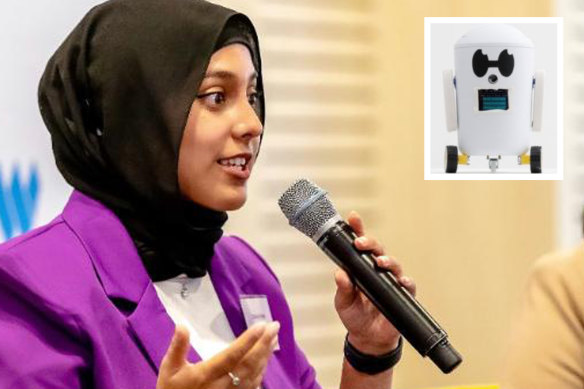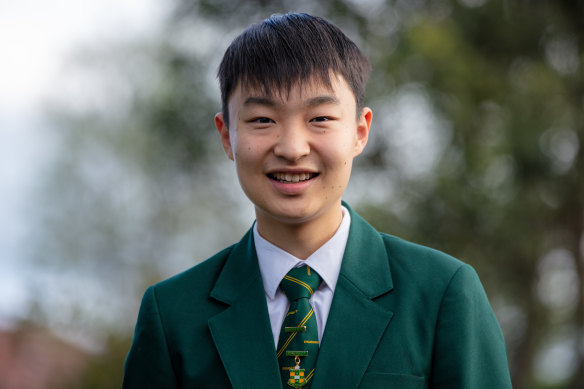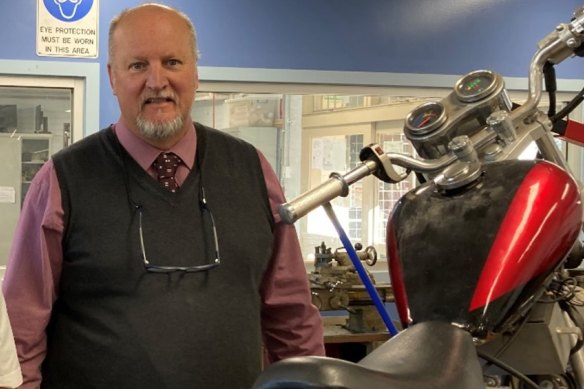How an old Disney movie inspired Daniya to create a medical robot
The future is now
Bright, ambitious and enthusiastic – Daniya Syed and Andrew Chung are breaking new ground as Australia’s next generation of innovators. We look at how HSC courses give students the chance to develop exciting new technologies and products for market.
Daniya Syed

Daniya Syed and her Medibot invention.
Daniya Syed could be described as one of the country’s brightest young minds. The former Unity Grammar student is paving the way for a new generation of women in robotics engineering, having created and patented an artificially intelligent social healthcare robot for her HSC Design and Technology subject.
Syed is not shy to share details of the surprising inspiration for her HSC major design project, an artificially intelligent healthcare robot Medibot: a 2014 Disney adventure movie.
“In fourth grade I watched a movie called Big Hero 6, which is essentially about a robot that helps people and monitors their wellbeing. I decided that I wanted to create my own version of that robot and spent the next six years learning as much as I could about robotics and engineering,” Syed said.
She immersed herself in the school’s robotics team and was soon representing Australia in international robotics competitions, held in Estonia in 2018, Japan in 2020 and Switzerland in 2022.
“I was selected as captain of Team Australia in 2022 for First Global Challenge – one of the biggest robotics competitions in the world, which was both incredibly exciting but stressful as it was going to overlap with my HSC exams,” Syed said.
“Fortunately, I was able to get a special exemption and sit my English exams in Switzerland, while simultaneously competing in the Robotics Olympics. Although it was tough studying, working on two major projects, and preparing for an international competition it was all worth it – we competed against 180 different countries and won silver.”
Syed is in the process of patenting MediBot, and continues to refine and develop the prototype.
“I’m studying Mechatronics Engineering at UTS so I can continue to develop MediBot – at the moment it can track blood pressure, heart rate, body temperature, dispense medicines and speak to patients,” she said.
“I want to get MediBot to a point where it’s a fully functioning robot that can travel autonomously and have more complex interactions with people – I’m committed to making it a viable solution for others. My goal is to create products that will help others.”
Among her many achievements, Syed was recently announced as a finalist in the 2023 NSW Young Woman of the Year Awards, was named the Western Sydney Young Woman of the Year 2021, and won the MacArthur Young Championship Technology and Innovation Award in 2021 and 2022. She also has a certificate of commendation from the Order of Australia in 2021 and was a nominee for the Young Australian of the Year Award in 2022.
She is also the co-founder of the Pakistani Youth Talent Awards hosted by not-for-profit organisation Meri Pehchan Pakistan which strives to acknowledge the achievements and talents of Pakistani youth across Australia.
“My HSC year could be simply described as a rollercoaster – I completed two major works in my final year and continued to compete in (robotics) competitions. It’s just about making sure you have the right balance and manage your time effectively,” Syed said.
“It was an amazing experience where I was able to test my limits and challenge myself.”
Syed’s tips for HSC Design and Technology
- Time management is key: “In terms of balancing a major project. You don’t want to focus too much on your major project so that everything else is lacking.”
- Try not to stress too much: “A lot of students think that if they don’t do well in the HSC, they’re doomed. It just isn’t true! There are so many opportunities and different pathways to get to where you want to go.”
- You don’t need to stop doing what you love: “I continued to compete in robotics competitions during my HSC. It’s just about making sure you have the right balance and managing your time effectively.”
Andrew Chung
Andrew Chung had always been fascinated by physics and electronics. But it was during his HSC year in 2022 that the Epping Boys High School student was able to challenge himself with an Industrial Technology project that really took his passion to the next level.
That project was exhibited at this year’s SHAPE exhibition, showcasing outstanding works from the 2022 HSC.

Industrial Technology ace Andrew Chung.
“I came up with the idea for a weather station as I wanted to work with sensors and it was an interesting idea that everyone could understand. It was always intended to be a prototype for something that could be used commercially,” Chung said.
“The weather station had multiple sensors for wind direction, wind speed, temperature, humidity and light. The sensors were connected to a micro controller (Raspberry Pi), which collected the info and output qualitative data on a screen.
“I went in with the ambition to create something that was easily accessible to the public and produced data that was easy to interpret.”
Needless to say, the technicalities were complex, but ingenuity and collaboration enabled Chung to solve every problem.
“There were many technical challenges throughout the project and most were overcome with research, online forums, and talking with peers and teachers,” Chung said.
His biggest piece of advice to students when it comes to their projects is to start early and make efficient use of their time.
“I strongly recommend completing as much of your project as you can as soon as possible. There will always be unforeseen events which will affect the timeline and progression of your project,” Chung said.
According to Chung, there’s no magic bullet when it comes to HSC prep.
“There can be a lot of white noise and theories about the exams. You may come across people trying to predict questions or study specifically because they have some ‘special insight’,” he said.
“Block it out. Study with friends to develop your knowledge, not to find an easy way through exams.”
Chung’s tips for HSC Industrial Technology written exams
- Know the syllabus and take good notes: “Make sure your notes and knowledge are close to ready for the HSC written exam well ahead of time. Look at past papers and practise answering questions. Starting early and having a passion was what allowed me to score a high band 6 (97) in Industrial Technology.”
- Take time out for yourself: “The HSC is most likely going to be one of the most challenging academic period of your life. While the focus is on exams, I strongly believe that you should take some time for yourself – find 30 minutes to go for a walk, call your friends, cook, do anything away from a screen or a textbook!”
- Study with peers and take charge of your routine: “Control what you’re able to control – exam prep, study notes, attentiveness in class, etc – that way you have no regrets. Also make sure to work with your peers. As my English teacher would say, ‘A high tide makes all the boats rise’.
- Find study tools that work for you: “For me, palm cards were really helpful. Ask friends how they study and see if any techniques work for you as soon as you can.”
Top tips from a HSC Industrial Technology teacher
Nigel Shakespeare
Head Teacher, Technological and Applied Studies
Plumpton High School

Teacher Nigel Shakespeare.
The Industrial Technology exam has two components: The Major Project and the written exam.
Major project
When selecting a major project, be realistic about your abilities. Select a demanding project that will challenge you, that you can finish to a high standard of quality without over-extending yourself – remember an unfinished or poorly executed project could highlight poor planning or a lack of skill and may not be marked highly. Consistent effort and sound planning will ensure a project is completed without unnecessary stress.
To enhance the quality of a Major Project – whether it’s for Timber Products and Furniture Technologies, Multimedia Technologies, Graphics Technologies, Automotive Technologies, Metal and Engineering Technologies, or Electronics Technologies – seek feedback and guidance from teachers, peers, and industry professionals. It’s also important to document the development and construction process, including any challenges and solutions that were encountered along the way.
Remember most projects encounter some problems or issues. Use these as an opportunity to demonstrate your problem-solving and project management skills. The problems encountered and the solutions to them should be highlighted in the Folio.
The major project also requires students to complete a Folio that serves as a record of a project’s development, from the initial concept to the final product. The Folio should demonstrate your planning, research, and project management skills, showcasing your ability to make informed decisions and adapt to unforeseen challenges.
To create an effective Folio, focus on telling the story of the project’s development, including all the critical decisions, research, time and budget management. Labelled sketches, diagrams, production drawings, screen shots and photographs that show the evolution of your ideas, as well as any relevant research into materials, processes, and technologies, are also worth including. Explain the decisions you make along the way, taking the opportunity to demonstrate your creativity, communication skills and technical abilities.
Students are also able to create a multimedia presentation, not exceeding six minutes duration, to showcase the functional aspects of the project, as well as additional design, management, and construction processes that may not be easily conveyed in the folio.
Written exam
The 90-minute written exam has three sections: multiple choice, short answer and extended response questions. You can find previous HSC exam papers on the NESA website.
The 10 multiple choice questions increase in difficulty, with 20 minutes suggested for completion. Use NESA’s multiple choice question generator for practice – and consider why the items you didn’t choose are not appropriate answers.
The second section of the paper contains the short answer questions based on the industry-related manufacturing technology studied. Take time to prepare study notes in your own words that contain short, succinct sentences, phrases or dot points to help them remember the content.
Complete past papers and use the NESA marking guidelines to mark your work to reinforce your understanding of type of answer required.
The third section is the extended response question. Respond to this question in relation to the focus area you have studied. Have a clear understanding of the impacts that structural, technical, social and environmental considerations have on the industry studied.
Take time to break down the question to ensure you understand what it is asking you to do. Highlight the key words in the question and take a few minutes to plan the written response. If it helps, utilise a writing scaffold such as ALARM or PEEL to help structure your response. Reinforce the points that you make using examples from the industry area that you have studied.
Practice is an essential part of developing effective writing skills, and it’s no different when it comes to the extended response writing required in HSC exams. To help prepare for the exam, practising your writing skills using past HSC exams under timed conditions can help. Use the marking guidelines and sample answers to review your efforts. This will help you to identify areas where you need to improve and learn how to structure your responses more effectively. It will also help you to understand what the examiners are looking for in a high-quality response, and how to achieve the highest possible marks.
If you finish early go back over the questions and your answers to ensure that you haven’t missed anything.